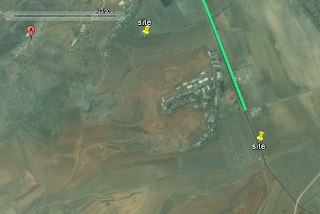Like all official residences (there are more than a dozen), security is tight. Kangdong airfield is nearby and the compound is surrounded on two sides with multiple anti-aircraft artillery sites.
You can get the full KMZ file of this compound for Google Earth here.
(click to view larger)
The above image is a large view showing everything. The main compound is off-center to the right, the dedicated rail line is in green (with another line being built [lighter color] which goes to 2 unknown facilities), the anti-aircraft artillery sites are marked with the red "A-drop" icon and the yellow & red lines are fences.
Below, gives a less cluttered look of the defensive positions with Kim Jong-un's residence marked.
Like all official compounds, the area is ringed with successive fences. Some are basic and others are electrified with multi-layered walls and firing positions (along with a vast network of foot paths).
The purple line marks out the main walls and surrounds the primary residences. Red denotes an outer "inner" wall, yellow is the outermost fence, and green marks out other basic walls surrounding various buildings.
Here is a close-up of the main residential section. There are 19-20 homes and you can see the wide fence/wall system surrounding the area.
Here is a larger view of the main compound.
Again, with fences showing and some places marked.
As I said earlier, there have been some additions. This is an image from 2004 showing the main residential compound, you'll notice the house I marked as possibly Kim Jong-un's isn't there and the horse track is different. There is imagery from 2006 without the additions but it was taken during winter and isn't as clear.
And the newly built train station.
Leading south from the train station is a road and bridge which crosses the Taedong River. Once you cross the river you come to a gate. This gate serves as one of many, but it is one of the main entrances. If you follow the northern route (take a left if you're on the road) you will end up at the main complex. If you take the road in the left of this image you will get to the first "satellite" compound (which is pictured further below).
Scattered around the complex are storage bunkers. Based on my understanding they're used to store fuel. However, some could be used to store anything and one or two may be large enough to be used as some kind of emergency bunker in the event of a war or attack.
A close-up. The rounded areas are the actual bunkers and it has a maintenance shed nearby.
There is also a very odd and very large area next to the horse tracks which covers the floor of some small valleys between hills. It is made up of hundreds (if not more) of these rectangular structures. Each are aligned side-by-side 10 or 12 feet apart. The whole area covers more than 230,000 square feet based on my calculations. I have no idea what they are, nor does anyone else I know.
Here are the other two smaller "satellite" compounds.
Here is the area in 2010 (track path is marked).
And the facilities as seen in the latest available imagery (2011).
I hope you enjoyed this little trip around Kim Jong-un's backyard.
--Jacob Bogle, 8/22/2013
www.JacobBogle.com
Facebook.com/JacobBogle
Twitter.com/JacobBogle



























